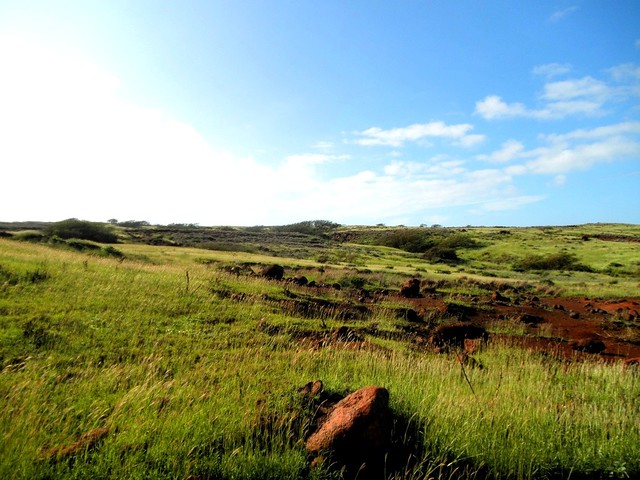I first noticed it on the drive from the airport into town. It was a homemade banner attached to the fence in front of a house and while simple, the message was clear. It was a photo of a windmill with a red line through it. I thought it was odd, but I quickly forgot about it until I stopped by the Lanai Culture & Heritage Center. This small, quirky little museum is a great way to learn more about the island not just from the exhibits but from the volunteers as well. I started chatting with them and within a few minutes the topic of the Lanai windmills came up. I quickly learned what this great debate was all about and I also started to get worried.
Lanai is not your average Hawaiian island. A shocking 98 percent of Lanai is owned by one person, David Murdock, President of Castle and Cooke, Inc. The odd ownership of a major Hawaiian island comes from its unique history. Castle and Cooke used to be the real estate division of Dole Food Company until it was spun off in the 1990s. Prior to that, Lanai was a possession of the giant fruit producer and at one time was the largest pineapple plantation in the world. Dole purchased the island in 1922, by which time most of the Lanaian lands had been consolidated by two men – Gibson and Gay.
Walter Murray Gibson was one of the original Haole settlers of the island in the 19th century. He and his family helped develop ranching and agriculture on the island and acquired title to much of the native lands. Then in the early 20th century, Charles Gay arrived and began a methodical process of buying large parcels of land on Lanai. By 1907 he owned all of Lanai with the exception of 100 acres of private property. It was Gay who established the single ownership model of Lanai and all future transactions have essentially meant the transfer in ownership of the entire island.
Since most of the island is owned by one person, that means he can do with it as he pleases. Also, keep in mind that most of the residents don’t actually own their homes. The entire island is very much a company town. Everyone works for Castle and Cooke and in turn they pay The Company for everything, from rent to snacks at the local convenience store. Weird, without question, but it’s a longstanding relationship that mostly works. Mostly.

Lanai Windmills
In 2008, Castle and Cooke announced plans for a windmill farm on Lanai. The farm would include 200 windmills built over 22,000 acres on the island’s north end. That equates to roughly 25 percent of the island which would be covered in windmills.
To provide some context, Lanai is small, very small, and only about 3,000 people call it home. The vast majority of these people live in and around the tiny village known as Lanai City. The north end of the island is for the most part uninhabited, virgin land.
Not only would this project destroy a quarter of Lanai, Lanai can’t even keep the power. Huge, undersea cables will be constructed feeding all of the power directly to Oahu. From my research, here are some of the possible negatives:
- Destruction of Lanai lands
- Serious concern for native bird species and migrating humpback whales due to the cable construction
- Significant change in Lanai social life due to new workers (an estimated 250)
What really bothers me though is the fact that the people who live on Lanai, whose families have called it home for generations, don’t have any say in this process. All they can do is watch the disaster unfold.
Anyway, to be fair here are the potential positives of the project:
- New jobs
- Helps Hawaii on the road to green energy
- Supply 15 percent of Oahu’s energy needs
- A proposed benefits package for residents to include reduced power bills and the ability to buy their homes fee simple
- Increased tax base

The people of Lanai have attempted to fight back. They’ve created a couple of groups, Lanaians for Sensible Growth and Friends of Lana‘i, they have lobbied the Statehouse and made travel bloggers cranky about it. But in reality there’s not too much that they can do. If Castle and Cooke can go through the massive variety of Federal and state regulatory hoops and satisfy the concerns of the legislature, then they’ll most likely construct this blight on Lanai. Their case is emboldened by the fact that Lanai has a history of large, eco-friendly power projects. Along the road to the Four Seasons Manele Bay is La Ola, Lanai’s Solar Farm. The Solar Farm is hidden in plain sight, most tourists have no idea that it’s there, just as the hope with the windmill farm. But La Ola is a far cry from the presence of two hundred, 400-foot monoliths that will forever mar the landscape of this most enchanting island.
I don’t know what will happen with this project, but I imagine it will probably be built. Will the ramifications be as dire as some say? Probably not, but regardless the fact that a quarter of this relatively untouched, beautiful island will be forever destroyed is a tragedy that hurts my heart. It is a scar on the land that can never be undone and I don’t think supplying Oahu residents with the power necessary to power their TVs and microwaves is worth the permanent disfiguring of what truly is a national treasure.
Photo credit: Lanai Windmill Sign Melanie Waldman, TravelsWithTwo.com

